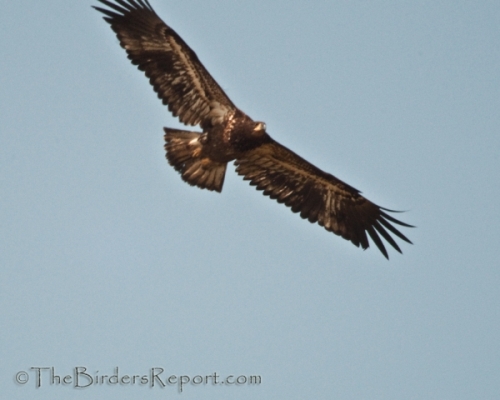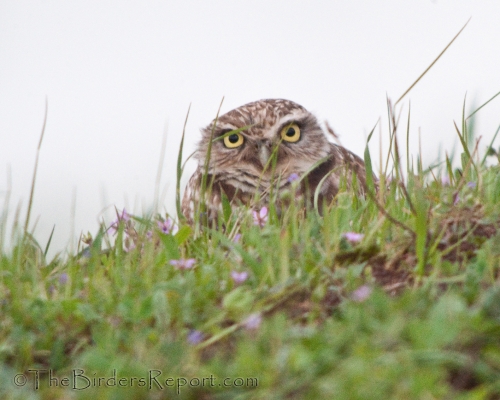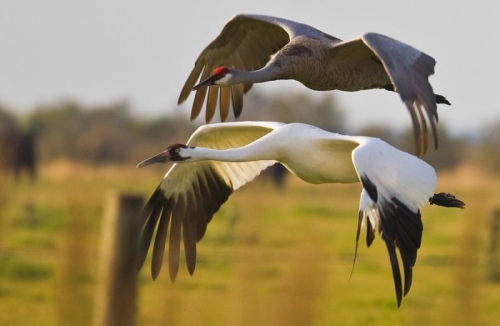
Bald Eagle (Haliaeetus leucocephalus) photo by Larry Jordan
Go check out my latest West Coast Beat Writer post “A Meal Fit For A King” at 10000 Birds!

Bald Eagle (Haliaeetus leucocephalus) photo by Larry Jordan
Go check out my latest West Coast Beat Writer post “A Meal Fit For A King” at 10000 Birds!
Ring-necked Pheasant (Phasianus colchicus) photos by Larry Jordan
I happened upon this Ring-necked Pheasant cock fight at Sacramento National Wildlife Refuge as I mentioned in a previous post. I thought I would put some of the better action photos in a group of collages and post them. If you click on any of the collage photos it will take you to a larger image of a single cock fight action shot.
It started as I was leaving the refuge and a pickup truck stopped in front of me and looked down this long trail in the grass. There was a pair of Ring-necked Pheasant cocks chasing each other down, what appeared to be a well worn trail.
Lucky for me, they turned around and started running back toward me, then away again. When they got about 50 yards away, they started in.
As you can see, it was pretty intense at times, just like two roosters going at it, but it never looked really serious to me.
If you look at the two birds in this photo, you will notice that the one on the right has white eyebrows and the one on the left has more gray eyebrows. I don’t know if this is due to the age of the bird or not but if you know why, please fill us in.
It was fun to watch and I actually filmed a video of part of the event. It is a little shaky because I was so far away and using my digiscoping setup but I think the 40 seconds is worth a look.
To see more great bird photos, check out Bird Photography Weekly and World Bird Wednesday!
 Burrowing Owl (Athene cunicularia) photos by Larry Jordan
Burrowing Owl (Athene cunicularia) photos by Larry Jordan
I had the pleasure of seeing two Burrowing Owls (Athene cunicularia) at our artificial nesting site in Chico yesterday before giving a presentation for the local Audubon Society meeting on this species of special concern in California. We have been seeing two or three owls at this site for over a month now so I am getting pretty excited at the possibility of having at least one breeding pair nesting this season!
I wanted to check on owls at two other locations before grabbing something to eat and heading over to the meeting location but it was getting rather dark with a big storm coming through. I could see huge thunderheads to the East, with large amounts of water falling to the ground beneath them heading my way.
I headed North on Lassen Road toward our second Chico Burrowing Owl site with a quick stop at Singer Creek to see if there were any owls in the large piles of rocks along the creek bank there, but I struck out. I did have some luck on Lassen Road though, catching a beautiful female Northern Harrier (Circus cyaneus) standing in the field along side the road.
I could tell that she was feeding on some type of prey animal so I slowly stopped the car on the side of the road to get some photos. I carefully attached the digiscope to the Groofwin and mounted it on my window.
I wanted to get some video of the event but shortly after snapping this photo, a huge pickup truck, with a cattle trailer clattering behind it, drove by at high speed scaring her away with her prey in talon. What a beautiful bird.
A bit further down the road I had the fortune of spotting one of the many American Kestrels I had seen that day, sitting on one of the fence posts separating the roadway from the miles of open grassland. I had been seeing them hunting the fields in their usual kiting fashion (a true joy to watch) but I had not been in position to photograph them.
I previously got lucky with a female American Kestrel (Falco sparverius) and now, here was a male sitting on a post, right next to the road. The lighting was not the greatest with that big storm heading my way, it was actually beginning to wet my windshield when I took this photo, but I was happy to get it.
I moved on to check on the second Burrowing Owl habitat, behind the old school house, before the clouds really let loose. Unfortunately, I saw no owl sign there.
With the rain coming down I headed to one of the premiere coffee shops in Chico and grabbed a cappuccino and a lemon bar. I previewed my photos and relaxed for a bit before heading to the nature center for what turned out to be a wonderful evening with a great group of birders at the Altacal Audubon meeting.
If you really like great groups of birders and bird photographs, head over to World Bird Wednesday, you’ll love it!

This photo was taken by Jim Rickards, I hope he doesn’t mind me using it
The thought of one of these beautiful birds being shot to death saddens me to the point of tears. What a ridiculous notion it would be to put the remaining 400 wild Whooping Cranes in danger of being shot to death for what some folks call “sport.”
Well, guess what? That is exactly what is happening. Five endangered Whooping Cranes were shot just this winter in Georgia and Alabama. There is a reward offered for information on these shootings of $23,250. Not a big enough reward even if we find the perpetrator, say I.
So, in case you haven’t heard about this situation, let me explain. Sandhill Crane “hunting” (I wouldn’t call it hunting, it’s really just shooting) is legal in 13 states in the West and Midwest, including nine of the 10 states in the Central Flyway. Sandhill Crane shooting seasons currently exist in Alaska, Arizona, Utah, Colorado, Kansas, Montana, New Mexico, North Dakota, Oklahoma, South Dakota, Texas, Wyoming and Minnesota.
There are groups of people now that want to open seasons on Sandhill Cranes in the Eastern United States, specifically Tennessee, Kentucky and Wisconsin. One of the big problems with this plan is that Whooping Cranes use this Eastern Flyway as a migration route and apparently some folks can’t tell the difference between the two species. This is not at all surprising for several reasons that most birders probably already know. Birds are sometimes hard to identify, even in good light.
I just finished reading the “Whooping Crane Eastern Partnership Five Year Strategic Plan” (download the PDF file here) and it looks like, and rightfully so, that they are very concerned about nesting success for the Eastern population of Whooping Cranes. Here is a quote from the conclusion of their plan (Part 4. Conclusion: A Look To The Future):
“Whooping cranes are charismatic birds that will require our long-term attention and support to fully recover from their near extinction in the 1940’s, when only 21 individual whooping cranes remained alive in the wild. A self-sustaining wild flock of whooping cranes that nests in Wisconsin and migrates south to wintering habitat is a crucial component for recovery of the species from its current status: in danger of extinction. The efforts of the Whooping Crane Eastern Partnership and our many supporters and contributors have resulted in great success in the first ten years of the reintroduction effort. The eastern migratory flock numbers nearly a hundred adult whooping cranes. As we work through the next five and ten years of the reintroduction effort, we intend to set this population on the path to long-term viability, so that whooping cranes become a familiar and expected part of the landscape in the eastern United States.
Seeing success in building and sustaining populations of long-lived, highly specialized species such as the whooping crane requires patience and sustained efforts over the long term. Whooping cranes in the wild often do not raise young until their third, fifth, or even seventh year, and even mature cranes may skip a year of reproduction in hard years. Therefore, population growth is slow, and seeing results in population recovery takes time.“
Does this conclusion look like opening a “hunting” season on Sandhill Cranes, with the likelihood of Whooping Cranes being shot a real possibility sound like a good strategy to you? The really odd thing is, one of the members of the Whooping Crane Eastern Partnership (WCEP) guidance team is the Wisconsin Department of Natural Resources. Yes that’s right, Wisconsin is one of the states considering hunting cranes!
It seems to me that if you are concerned about nesting success of Whooping Cranes in an ongoing program that began ten years ago and is having good success because of a lot of hard work, money spent and support by the general public, you would be even more concerned about adult birds being killed and losing five of the birds that made it to adulthood. This is a no-brainer is it not? Opening a “hunting” season on Sandhill Cranes will surely lead to the loss of endangered Whooping Cranes!
Julie Zickefoose has just written a post entitled “The Nonessential Whooping Crane” that you can read over at 10000 Birds. Please do so. In it she explains why this is a really bad idea.
My friend Vickie Henderson, who has been a real leader on this issue, has also written a fine piece entitled “Sandhill Crane Hunting in the East? Why?” in which she tries to explain why this would even be considered. Go read it!
Both of the above posts have several links to people we all need to write to, stating our opposition to the proposed Sandhill Crane slaughters. I wholeheartedly urge you to write letters opposing the killing of this exquisite species and possibly the endangered Whooping Crane to:
The Honorable Ken Salazar, Secretary of the Interior
Department of the Interior
1849 C. Street, N.W
Mail Stop 7060 Washington, D.C. 20240
and:
Rowan W. Gould
Secretary, U.S. Fish and Wildlife Service
1849 C Street NW
Washington, DC 20240
I also ask you to sign the petition asking for a review of the Management Plan for the Eastern Population of Sandhill Cranes here.
If you don’t think you have the time to write these letters or sign the petition, just take a look at the video below. If you have already made up your mind to write the letters and sign the petition, please DO NOT watch the video. It will most likely make you sick to your stomach.
Thank you for your support on the Sandhill Crane issue and if you really want to help the Whooping Crane cause, you can donate to Operation Migration like I do. Thanks!
Social Media Connect